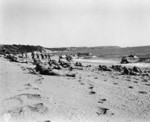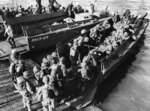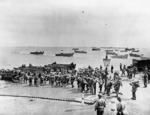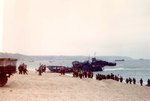Exercise Tiger
Contributor: Hugh Martyr
ww2dbaseAnybody visiting the picturesque beach at Slapton on the southern coast of the County of Devonshire in England, United Kingdom would be hard pressed to see any evidence of the tragic events that occurred there. There is a Sherman tank at the edge of the beach and a memorial to those who lost their lives and this memorial outlines the story.
ww2dbaseIn the build up to D-Day the Allies were stockpiling equipment and the number of servicemen being brought into southern England grew by the day. The few people that knew of the Normandie (English: Normandy), France invasion plans were well aware that no matter how good the materiel and how high the morale of the men, there was a need to train the troops and test the ability to land tanks, their support vehicles and the men onto a beachhead.
ww2dbaseSlapton had been marked down as a training site for the American forces due to its similarities with the beaches at Normandy on which they would land and the river at Dartmouth nearby was ideal to develop as a docking and embarkation site for the large landing craft that were being built for the invasion forces. There was a huge need for secrecy; only a few high up the command chain knew that Normandy had been chosen for invasion. This meant a huge evacuation of the small nearby villages. Slapton, East Allington and surrounding houses were emptied of all civilians, over 3,000 in all. Some had friends and relations to stay, others were re-housed using the same procedure as people whose houses had been destroyed in the London Blitz. Such was the security that none were given any reason why. A large camp was built in Slapton's Coronation Park and along the river, moorings, slipways and ramps were built.
ww2dbaseThe training for the Normandy invasion would be known as Exercise Tiger and would undertake to train troops to embark the landing craft with all equipment and give the naval crews experience in maneuvering the loaded craft in realistic conditions. By the beginning of Apr 1944, the area was full of American soldiers and vehicles, mainly tanks and the supporting trucks. The overall commander for Exercise Tiger was General Dwight Eisenhower and he wanted to make the exercise as realistic as possible so defending troops on shore together with artillery would fire live ammunition over the heads of the attacking force. This would give the men the feel of "the real thing" and test the ability of the men to communicate under fire.
ww2dbaseFor three days starting on the 22 Apr 1944 the American forces went through drill after drill as to be able to embark quickly and get out to sea. The naval personnel learnt how to control their large heavily laden landing craft in open water conditions in the dark under black out. The final stage of the exercise was to simulate a landing by embarking the invasion force and steering a course out to Lyme Bay and then swing in to the landing zone at zero hour (0730 hours) on 27 Apr 1944.
ww2dbaseAs usual in these operations there were delays in getting some of the craft loaded and the Officer in Charge, American Admiral Donald P. Moon, delayed the zero hour by 60 minutes. Now came more problems, some of the landing craft did not get the signal meaning that the second wave would be in a position behind the first exactly where the live artillery would be landing. Casualties were inevitable and as many as 400 dead and wounded Americans was the result.
ww2dbaseThe day after these first practice assaults, early on the morning of 28 Apr 1944, Convoy T-4, of eight LSTs carrying tanks and combat engineers from 1st Engineer Special Brigade was met by a flotilla of German Schnellboote (English: E-boats) under command of Korvettenkapitän Bernd Klug as they crossed Lyme bay. There were two ships assigned as convoy escorts and one, the corvette HMS Azalea was at the head of a column of the LSTs, this fact presented the German crews a wonderful target, each could select a landing craft with little in the way of return fire. The second ship, HMS Scimitar, an old WW1 destroyer had earlier been in collision with a landing craft and had left the convoy to seek repairs.
ww2dbaseAs the attacking E-boats came in, it was found that the headquarters' staff had issued the American and British forces with differing radio frequencies. Thus, the Americans were unaware at first that the oncoming ships were hostile.
ww2dbaseThe attack was over very quickly, and the result was chaos. LSTs were sinking quickly, dragged under by the heavy tanks on board. Many servicemen had had no drill as to how to put on life jackets correctly, due to their large backpacks they had been instructed to tie them around their waist. The result of this meant that as soon as they were in the water they flipped over and drowned. Many crews were inside their tanks and had no idea that they were under attack, the Sherman tanks slid off the decks taking crews with them. Those that were lucky enough to get to a lifeboat reported their distress at the huge amount of dead men that were floating by and with the cold water many in the lifeboats were suffering as they were in the dark with no idea of which way to steer to safety.
ww2dbaseThere were huge concerns and embarrassment over the disaster, all survivors were sworn to secrecy about what had happened. There were ten missing officers that were in the BIGOT level security clearance about the Normandy invasion and there was no way of telling whether any had been captured or whether they were carrying documents that were of top-level classification.
ww2dbaseThere is little information of how high the death toll was. The US Department of Defense stated in 1988 that the record keeping was inadequate upon the LSTs at the time and all log books had been lost at sea. Rumors started very soon after the event with stories of mass graves being dug and it would never be known exactly who died or upon which LST they were. The generally accepted figure is 749 servicemen were killed including 197 naval personnel. The dead servicemen were added to the overall casualty figures for D-Day. There are accusations of a cover up over the Slapton affair, but it is generally thought that the initial secrecy just led to an attitude of convenient forgetfulness.
ww2dbaseChanges were however put in place very quickly; the radio frequencies were standardized and small craft were planned to accompany LSTs on D-Day. The whole back-pack and life vest drill was re-organized and tank crews would mount their vehicles later in the journey.
ww2dbaseThe lessons learnt at Slapton came at a high cost; perhaps the most important fact was that the Allies had to work and plan without self-guarded interests and that the services themselves needed to cast aside suspicions of each other.
ww2dbaseFamilies returned after the war and Slapton is now once again a peaceful holiday village and the sandy beaches once more are home to pic-nickers and wildlife. Occasionally, after storms, buttons and other items are washed ashore whilst out in the Bay the LSDs and the tanks they carried lie on the sea bed, home to fishes and providing interesting dives for people.
ww2dbaseSources:
Lewis, Nigel (2017). The Cover Plan Conspiracy: The British and Exercise Tiger, 1944
Garn, Kenneth H. (2004). The Secret D-Day. ISBN 0-7884-2512-9
Slapton Village Tiger
History of Exercise Tiger from the West Virginia State Archives
Last Major Update: May 2019
Exercise Tiger Interactive Map
Photographs
 |  |  |  |
Exercise Tiger Timeline
| 22 Apr 1944 | American forces conducted marshalling and embarkation drills at Slapton, Devonshire, England, United Kingdom. |
| 23 Apr 1944 | American forces conducted marshalling and embarkation drills at Slapton, Devonshire, England, United Kingdom. |
| 24 Apr 1944 | American forces conducted marshalling and embarkation drills at Slapton, Devonshire, England, United Kingdom. |
| 25 Apr 1944 | American forces conducted marshalling and embarkation drills at Slapton, Devonshire, England, United Kingdom. |
| 27 Apr 1944 | American forces conducted a practice amphibious assault at Slapton, Devonshire, England, United Kingdom. Live artillery fire was used to simulate German defenses; in an episode of friendly fire, an estimated 400 Americans were killed as the shells came down amongst the men of the second wave. |
| 28 Apr 1944 | A group of German Schnellboote (E-boats) came across an American landing exercise at Slapton, England, United Kingdom and launched an attack, sinking two LSTs and damaging other craft, killing 198 sailors and 551 soldiers. |
Did you enjoy this article or find this article helpful? If so, please consider supporting us on Patreon. Even $1 per month will go a long way! Thank you. Share this article with your friends: Stay updated with WW2DB: |
» United Kingdom
- » 1,150 biographies
- » 337 events
- » 43,914 timeline entries
- » 1,241 ships
- » 350 aircraft models
- » 207 vehicle models
- » 372 weapon models
- » 123 historical documents
- » 260 facilities
- » 470 book reviews
- » 28,532 photos
- » 432 maps
Winston Churchill
Please consider supporting us on Patreon. Even $1 a month will go a long way. Thank you!
Or, please support us by purchasing some WW2DB merchandise at TeeSpring, Thank you!